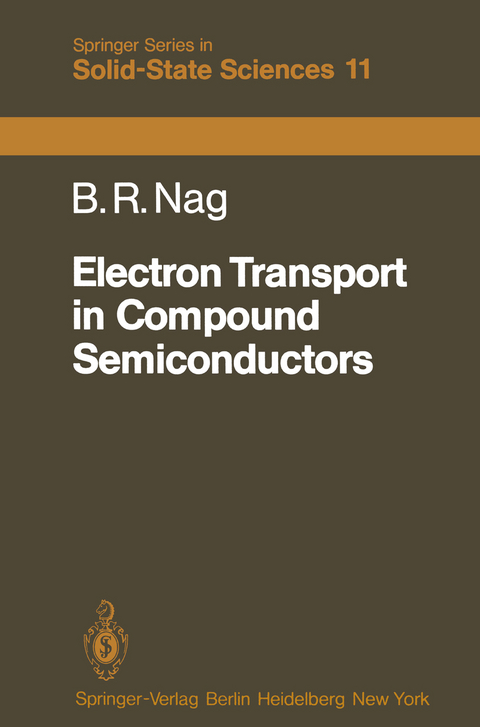
Electron Transport in Compound Semiconductors
Springer Berlin (Verlag)
978-3-642-81418-1 (ISBN)
1. Introduction.- 1.1 Historical Note.- 1.2 Applications.- 1.3 Transport Coefficients of Interest.- 1.4 Scope of the Book.- 2. Crystal Structure.- 2.1 Zinc-Blende Structure.- 2.2 Wurtzite Structure.- 2.3 Rock-Salt Structure.- 2.4 Chalcopyrite Structure.- 3. Energy Band Structure.- 3.1 Electron Wave Vector and Brillouin Zone.- 3.2 Brillouin Zone for the Sphalerite and Rock-Salt Crystal Structure.- 3.3 Brillouin Zone for the Wurtzite Structure.- 3.4 Brillouin Zone for the Chalcopyrite Structure.- 3.5 E-k Diagrams.- 3.6 Conclusion.- 4. Theory of Efiergy Band Structure.- 4.1 Models of Band Structure.- 4.2 Free-Electron Approximation Model.- 4.3 Tight-Binding Approximation Model.- 4.4 Energy Bands in Semiconductor Super!attices.- 4.5 The k-p Perturbation Method for Derivating E-k Relation.- 4.6 External Effects on Energy Bands.- 5. Electron Statistics.- 5.1 Fermi Energy for Parabolic Bands.- 5.2 Fermi Energy for Nonparabolic Bands.- 5.3 Fermi Energy in the Presence of a Quantising Magnetic Field.- 5.4 Fermi Energy and Impurity Density.- 5.5 Conclusions.- 6. Scattering Theory.- 6.1 Collision Processes.- 6.2 Transition Probability.- 6.3 Matrix Elements.- 6.4 Free-Carrier Screening.- 6.5 Overlap Integrals.- 6.6 Scattering Probability S(k).- 6.7 Scattering Probabilities for Anisotropic Bands.- 6.8 S(k) for Neutral Impurity, Alloy, and Crystal-Defect Scattering.- 6.9 Conclusions.- 7. The Boltzmann Transport Equation and Its Solution.- 7.1 The Liouville Equation and the Boltzmann Equation.- 7.2 The Boltzmann Transport Equation.- 7.3 The Collision Integral.- 7.4 Linearised Boltzmann Equation.- 7.5 Simplified Form of the Collision Terms.- 7.6 Solution of the Boltzmann Equation.- 7.7 Method of Solution for Anisotropic Coupling Constants and Anisotropic Electron Effective Mass.- 7.8 Conclusions.- 8. Low-Field DC Transport Coefficients.- 8.1 Evaluation of Drift Mobility.- 8.2 Drift Mobility for Anisotropic Bands.- 8.3 Galvanomagnetic Transport Coefficients.- 8.4 Transport Coefficients for Nonuniform conditions.- 8.5 Conclusions.- 9. Low-Field AC Transport Coefficients.- 9.1 Classical Theory of AC Transport Coefficients.- 9.2 AC Galvanomagnetic Coefficients.- 9.3 Cyclotron Resonance and Faraday Rotation.- 9.4 Free-Carrier Absorption (FCA).- 9.5 Concluding Remarks.- 10. Electron Transport in a Strong Magnetic Field.- 10.1 Scattering Probabilities.- 10.2 Mobility in Strong Magnetic Fields.- 10.3 Electron Mobility in the Extreme Quantum Limit (EQL).- 10.4 Oscillatory Effects in the Magnetoresistance.- 10.5 Experimental Results on Magnetophonon Resonance.- 10.6 Conclusions.- 11. Hot-Electron Transport.- 11.1 Phenomenon of Hot Electrons.- 11.2 Experimental Characteristics.- 11.3 Negative Differential Mobility and Electron Transfer Effect.- 11.4 Analytic Theories.- 11.5 Numerical Methods.- 11.6 Hot-Electron AC Conductivity.- 11.7 Hot-Electron Diffusion.- 11.8 Conclusion.- 12. Review of Experimental Results.- 12.1 Transport Coefficients of III-V Compounds.- 12.2 II-VI Compounds.- 12.3 IV-VI Compounds.- 12.4 Mixed Compounds.- 12.5 Chalcopyrites.- 12.6 Conclusion.- 13. Conclusions.- 13.1 Problems of Current Interest.- 13.2 Scope of Further Studies.- Appendix A: Table of Fermi Integrals.- Appendix B: Computer Program for the Evaluation of Transport Coefficients by the Iteration Method.- Appendix C: Values of a. and b. for Gaussian Quadrature Integration. 417 Appendix D: Computer Program for the Monte Carlo Calculation of Hot-Electron Conductivity and Diffusivity.- List of Symbols.- References.
| Erscheint lt. Verlag | 15.12.2011 |
|---|---|
| Reihe/Serie | Springer Series in Solid-State Sciences |
| Zusatzinfo | XVI, 464 p. |
| Verlagsort | Berlin |
| Sprache | englisch |
| Maße | 155 x 235 mm |
| Gewicht | 726 g |
| Themenwelt | Naturwissenschaften ► Physik / Astronomie ► Atom- / Kern- / Molekularphysik |
| Naturwissenschaften ► Physik / Astronomie ► Festkörperphysik | |
| Naturwissenschaften ► Physik / Astronomie ► Thermodynamik | |
| Technik ► Elektrotechnik / Energietechnik | |
| Schlagworte | band structure • Crystal • crystal structure • Diffusion • electron • Energy • Halbleiter • Material • scattering • semiconductor • Semiconductor physics • Transport • Transporterscheinung |
| ISBN-10 | 3-642-81418-2 / 3642814182 |
| ISBN-13 | 978-3-642-81418-1 / 9783642814181 |
| Zustand | Neuware |
| Haben Sie eine Frage zum Produkt? |
aus dem Bereich


